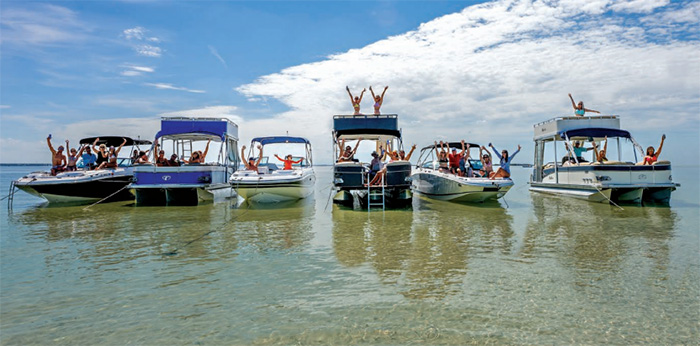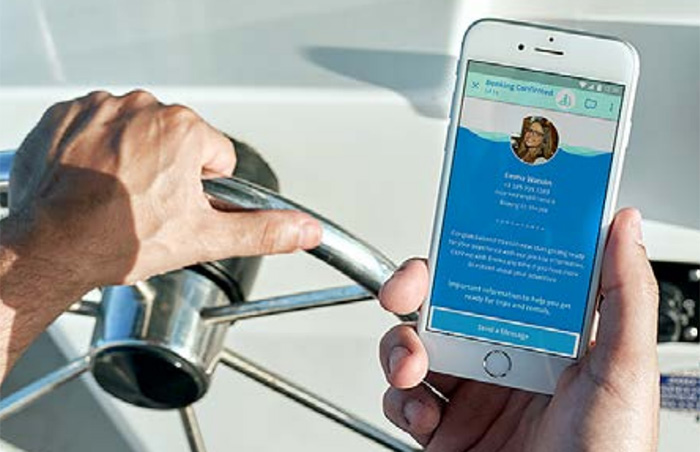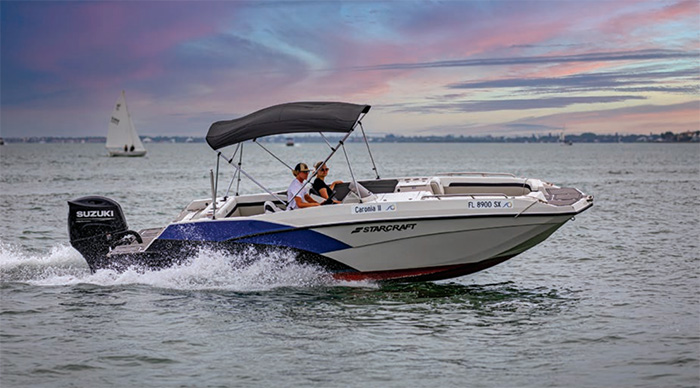Advertisement
As the sharing economy roils the waters of traditional boat ownership, it presents alternative ways to get out on the water for recreational boaters, and money-making opportunities for owners and captains.

Photo: Boatsetter
Our lifestyle is awash in painfully funny puns about the cost of boating. But expenses and budgets are a part of life, and boat ownership can be pricey. Some people co-own boats or downsize to trim costs. Others opt for boat clubs (different than yacht clubs), fractional ownership, or peer-to-peer rentals – options growing in popularity. Let’s look how these categories work.
Boat clubs
A one-time membership fee earns admission to share a private fleet of boats among fellow members, and members generally pay a monthly fee as well. Prices vary depending on location (i.e., it’s more expensive in metropolitan areas). The club covers insurance, taxes, maintenance, repairs, slip, winterizing, and storage; you pay for your fuel. Beyond their home fleet, members often have access to various boat types and locations at other company franchises to explore different cruising grounds.
Fractional ownership
Fractional ownership is a way for boat owners to defray costs. That’s because they don’t own the entire boat, just part of it – typically half, a quarter, or smaller percentage. Companies like Sailtime and Sovereign Boat Club bring together like-minded owners each willing to purchase a designated percentage of a boat, allowing the parties to afford larger, more expensive vessels than they could buy on their own. The company typically manages and takes care of all maintenance and storage costs, and if your situation changes, you can sell your ownership interest. The downside is that your boat isn’t really yours to personalize, and you don’t control when it’s launched or hauled for the off-season.
Peer-to-peer
Short-term home rentals shook up the hotel business when Airbnb took flight in 2008, followed by Uber disrupting the taxi business in 2011. Applying the model to boating was inevitable. Peer-to-peer (P2P) boat rental is a service that facilitates renting a boat directly from the owner, as opposed to a rental company. Owners set their own calendars of boat availability, which you can see online (along with reviews from prior customers). If you select that boat, you confirm the dates and if you want a captain, and the P2P company handles the payment to the owner. Users simply step aboard, head out, tie up at the end of the day, and can be on their way.
“Currently, 61% of our owner community is under the age of 45,” says Jackie Baumgarten, founder of Boatsetter, the largest P2P boat rental franchise in the U.S. with more than 50,000 boats for rent. “Millennials make up the largest segment of owners at 43%, with Gen Xers close behind at 36%.” Boatsetter reports nearly 175% growth in annual bookings since 2020.

Photo: Freedom Boat Club
Spotlight: Freedom Boat Club
The world’s oldest (founded in 1989) and largest membership boat club with more than 80,000 members globally offers reciprocal access to more than 380 locations in the U.S., Canada, Europe, and most recently Australia. Boat sizes typically range from 17 to 25 feet and are a mix of pontoons, deckboats, bowriders, and fishing boats. Some locations include wakeboard boats, sailboats, and kayaks. Membership fees and monthly dues vary by location and membership type, but members can expect to pay a one-time entry fee between $4,000 and $6,000 with dues starting at $299/month (weekday membership rates are reduced).
“We find that a large majority of our members aren’t considering a new boat purchase when they join the club,” says Cecil Cohn, president of Freedom Boat Club. “So rather than comparing ownership versus boat club membership, we’re often walking potential new members through the benefits of life in the club, including access to unlimited training, concierge-like service at the docks, and access to our fleets all over the world.”
“More than one-third of our new members are female,” he reports. “And we’re making significant inroads across many other demographics of first-time boaters. We pride ourselves on attracting new entrants to boating earlier in life than the typical age range of boat ownership, while also retaining boaters aging out of the typical ownership age range who want to maintain access to on-water experiences. Young professionals and the next generation of boaters are driving membership.

The Boatsetter app allows armchair skippers to discover boating aboard your vessel, but only for an hourly fee, and only within the parameters you set. Photo: Boatsetter

Photo: Bernadette Bernon
Spotlight: Boatsetter
Founded in 2012, the largest fleet of peer-to-peer boat rentals offers 700-plus locations and more than 50,000 boats worldwide, with no entry fee or monthly fees. A 15-minute online form gets things started. Owners have final say on pricing, scheduling, and the right to refuse any applicant, and are paid securely via direct deposit within three days after each completed booking. The owner handles all maintenance, cleaning and repairs as the boat remains in its home slip or mooring. It’s free to list your boat; rentals generally cost anywhere from $50 to several hundred dollars per hour (plus service fees and taxes) depending on boat size and location. You can opt out at any time.
Boatsetter has created a collaborative community that helps people monetize a traditionally underutilized asset and helps defray the cost of ownership. Boatsetter customers search online for the locale and boat type they’re interested in, then connect with the boat owner through the Boatsetter website to book dates. U.S. Coast Guard-licensed captains may be available for hire if you don’t want to skipper the boat yourself.
Boat owners tend to be protective of their babies, so Boatsetter’s business philosophy is, “It’s their boat, their rules. They have total control over scheduling and availability, booking price, start times, trip durations, and who is allowed to operate their boat,” Baumgarten says. “Owners can set their own qualifications to verify a renter’s experience, giving them full control.” According to Boatsetter, more than 40% of past renters surveyed are current boat owners.
Millennials make up Boatsetter’s largest segment, both on the renter and owner side, but the company also counts young families and retirees among its membership. The sharing model also attracts entrepreneurs who put multiple boats into service, which covers the cost of ownership and membership — and maybe offers a profit! boatsetter.com
Boat club membership: To join or not to join
Pros
- Variety of boat types and sizes, variety of cruising grounds
- Boats are replaced with new models every few years
- No bills for maintenance, repairs, winterizing, slip, insurance
- Professional boating education, one-on-one training
Cons
- A boat you’d like to take out on the spur of the moment may have been reserved by someone else on that day.
- There’s a fairly hefty nonrefundable fee upfront to join.
- There may be some restrictions and/or required training for overnight use.
- Monthly fees typically continue year-round. — R.A.
Tip

Photo: GetMyBoat
App-Based Peer to Peer
GetMyBoat
Calling itself the No. 1 app for boat rentals and charters, fishing charters, houseboat rentals, and themed excursions, GetMyBoat has more than 150,000 watercraft in more than 9,400 locations worldwide, and 2.5 million unique visitors per year. Most of the listings are U.S.-based, with some international. Creating a boat or water experience listing is free. Owners set their own prices, and an 8.5% service fee covers management of the platform, 24/7 customer service, identity checks, fraud protection, and marketing services. getmyboat.com
ClickandBoat
Based in France, most of its rentals are in Europe, but also in U.S., Asia, and the Caribbean. Part Airbnb, part Uber, ClickandBoat matches clients with boat owners via its website or app. More than 40,000 private yacht charters and peer-to-peer boat rentals are listed. Creating a boat listing is free. Users charter their boats to whomever they want, whenever they want, at whatever price they set. clickandboat.com/us

Photo: Suntex
Regional & Niche Options
They may not have the geographical reach of the big boys, but these businesses could be a perfect fit for the right boater.
Boat Clubs
Carefree Boat Club
Founded in Virginia in 2002, Carefree has more than 120 locations across North America. Costs include a one-time $3,500-$5,000 initiation fee, followed by $250-$350 monthly dues. Member-to-boat ratios are typically 10 members per boat. All boats are 16 to 25 feet and replaced with new models every one to three years. Free unlimited on-water training by Coast Guard-licensed captains. Overnighting is an option. Reservations can be made up to six months in advance. carefreeboats.com
Nautical Boat Club
Calling its business model the first and only “boating country club,” Nautical has 16 locations in Texas, Tennessee, South Carolina, Georgia, and Wisconsin. To join, you pay a one-time membership fee of $8,000, followed by monthly dues of $600. Prices vary slightly by location. Members have unlimited use of a fleet of new boats more than 300 days a year, and the club touts fulfilling more than 97% of all reservation requests. In business for more than 20 years, Nautical was one of the pioneers in the boat-club industry. The private club owns, insures, outfits, and maintains a fleet of recent models that are replaced every two to three years. It also offers complimentary water toys, like skis, wakeboards, and tubes, and life jackets. Staff dockhands are on site to help load and unload, and answer questions. The club provides a boating safety course and hands-on instruction for newcomers. nauticalboatclub.com
Suntex Boat Club
Making its name with dozens of high-end marinas the company owns and manages across 14 states, Suntex Boat Clubs based in Suntex marinas was launched 10 years ago. For a one-time $3,800 entry fee and $430 monthly, members have full- or half-day access to boats at any of the 20 clubs located in Texas, Georgia, Oklahoma, Iowa, Florida, California, Kentucky, Tennessee, and Arizona, and can stack up to three reservations. New members receive a one- to two-hour safety orientation. suntexboatclub.com
Fractional Boat Ownership
Sovereign Boat Club
SBC offers shared access to a particular high-end boat, or group of high-end boats in Florida — such as upscale, 27-foot and larger powerboats — while defraying the cost of ownership. The current SBC fleet includes brands like Boston Whaler, Pursuit, Edgewater, Everglades, and Robalo that cost from $250,000 to $900,000. Members can take multi-day overnight trips annually. Most boats have joysticks and two or more engines; all have electric-flush heads, can go up to 50 miles offshore, and are equipped with chartplotters and VHFs.
Most of SBC’s boats are privately owned. The club manages their boats for the owners, selling the owner’s unused time in the form of memberships. SBC vets and trains members to operate the boat and systems. For the boat owner, this covers all operating costs, offsets depreciation, and helps pay down the debt when the boat is kept in the club, also making the owner eligible for tax deductions under Section 179. The club offers three- to six-month seasonal memberships. Membership is limited to a maximum of eight members in each boat; SBC says a 6-to-1 ratio is common. Each member can stack four reservations on the calendar at any time. All members can book four consecutive days. sovereignboatclub.com
Sailtime
Founded in 2001 in Austin, Texas, SailTime is the largest fractional boat club in the world. Created as a sail-exclusive organization, SailTime recently added powerboats to its fleet as SailTime Power. The club offers two ways to get into boating – membership or ownership. Membership gets access to the fleet; ownership comes with a financial stake in a fleet boat, which generates revenue for the owner as one boat owner shares their boat with up to six members. SailTime manages the costs and provides the owner with consistent monthly revenue through the membership program. The local base manager handles all regular maintenance, preventive care, and repairs. SailTime members are professionally trained on and sail the same boat all season long for an upfront fee of $1,500 to $2,500 (depending on location). Everything is included in the membership fee, starting at $495/month (depending on boat size, membership type, and location) — even the maintenance, insurance, marina fees, cleaning, and fuel. Fractional Membership is offered in three tier levels: Lite (three uses/month), Classic (seven uses/month) and Premier (14 uses/month), so you get guaranteed sailing that best meets your cruising needs. sailtime.com
